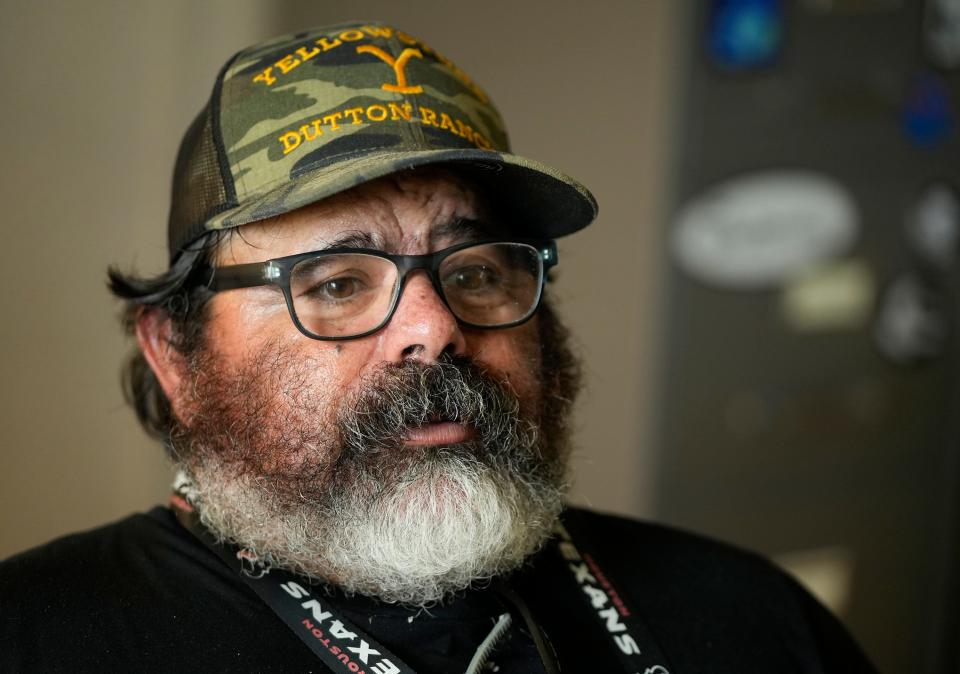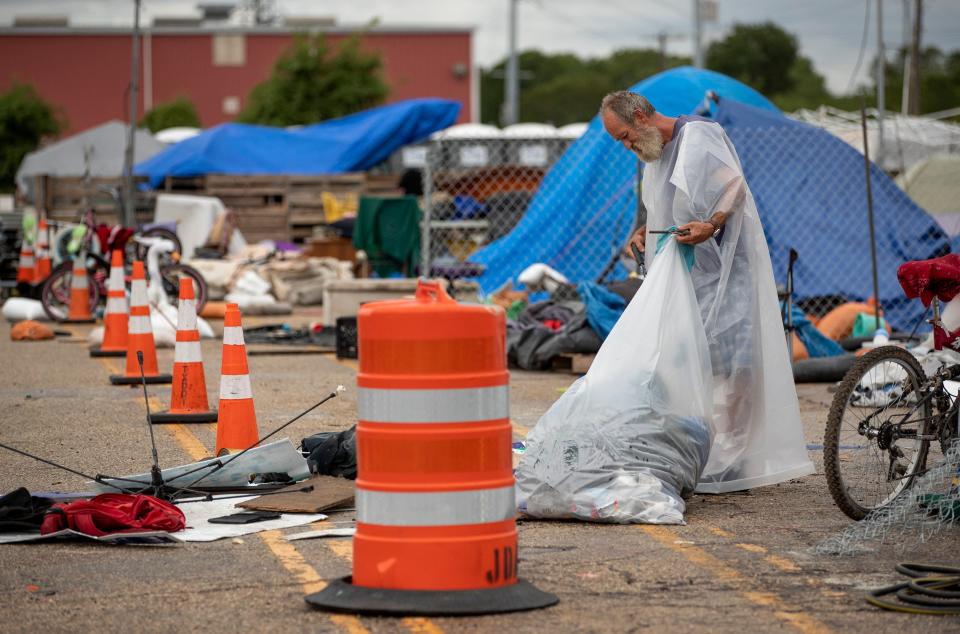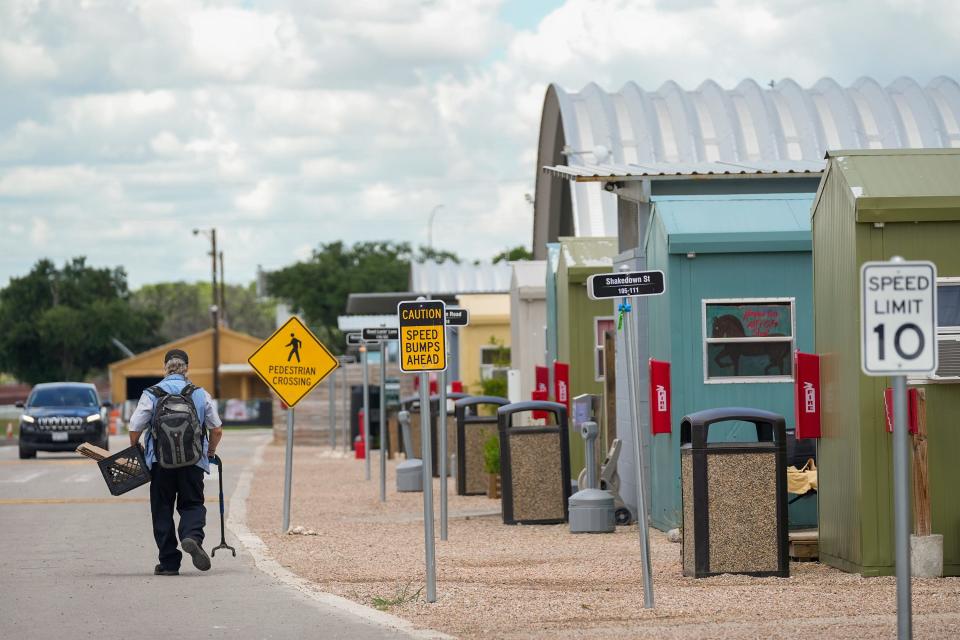How colorful cabins and a Grateful Dead spirit are helping people out of homelessness | Grumet
It was a sweltering June afternoon, too hot to sit on the front porch for too long. Michael Nieves walked next door to the Quonset hut — a community hub with picnic tables, string lights and a refreshment stand, all under a giant metal arch — and grabbed a large bag of ice to carry back to his cabin.
When he first arrived in early 2020 at the old highway department maintenance yard off U.S. 183 that would become the Esperanza Community, home was a tent on the scorched asphalt. Now, Nieves lives in a pale yellow cabin with a red door, a 10-by-12-foot space with a bed, a window air-conditioning unit and a cooler where he keeps milk and Powerades on ice.
“We're homeless people, but we're not different,” said Nieves, 54, known to everyone at Esperanza as Mikey. “We just don't have certain (things) that everybody else has, like a job and being able to get a car or buy a house.”

Esperanza is in the business of transformation, not only helping people find their path out of homelessness, but revamping the model for homeless shelter services. Expansions planned over the next few years could make it the largest emergency shelter in Austin. If you’re looking for a place to find hope after Friday's U.S. Supreme Court decision upholding the legality of camping bans that criminalize homelessness, Esperanza is a good place to start.
Laws, citations and court rulings don’t end someone’s homelessness. Places like Esperanza can.
From asphalt lot to homeless community
Walking past the rows of tidy, single-occupancy cabins — painted shades of teal, azure, olive and cream — it’s hard to believe this 7-acre site began as a state-sanctioned homeless campsite, established in 2019 by Gov. Greg Abbott. Back then, the lot quickly filled with tents and other dwellings patched out of plywood, cardboard, tarps and tires.
It was a place to be safe from the homeless camp sweeps happening under highway overpasses, but it was still no place to live. More than 180 residents baked in the summer heat and suffered through winter freezes. Nieves recalled a few troublemakers and rampant theft.
When The Other Ones Foundation arrived in the summer of 2020 to manage the site, spokesman Max Moscoe told me, “It quickly became apparent the situation was unsafe and undignified.”

Notably, the nonprofit conducted surveys and extensive conversations with the residents to develop plans that fit their needs. When nearly 95% said they would stay in individual cabins (compared with only 15% who would agree to stay in a large congregate shelter), the microshelter concept took root.
Thanks to a mix of government money, private dollars and in-kind donations of construction work, the cabins started going up in September 2021. By December 2022, all tents were gone. Now the site has 100 cabins, all climate-controlled and with locking doors; plus four rows of single-occupancy restrooms with showers, two community hubs and offices providing case management and peer support services.
In the coming year, the nonprofit will build an identical second phase, adding another 100 cabins. At that point, Esperanza will be larger than the city-owned ARCH shelter for men downtown (130 beds), the Eighth Street shelter for women (163 beds) and the Northbridge (125 beds) and Southbridge (145 beds) transitional housing facilities.
Meanwhile, the state Department of Transportation recently announced it bought a neighboring 7 acres so Esperanza can double its footprint, serving people whose campsites will be displaced when crews start the massive reworking of Interstate 35.
The Other Ones is weighing what those additional acres could hold: More individual cabins? Or some other configuration of shelter options? By then, Esperanza will have its original 200 cabins built, so the expansion onto the new acreage could make the entire shelter complex larger than Austin’s 300-bed Marshalling Yard shelter, a temporary facility with an uncertain future past March 2025.

Maintaining a sense of community will be a test for The Other Ones as Esperanza expands. Clients can earn $20 an hour picking up trash, driving a shuttle around the community or doing other work, providing income and fostering a sense of shared purpose. The cabins are grouped around the Quonset hut gathering hubs, off gravel-lined pathways with names like Ripple Road, Dancing in the Street and Morning Dew Way — which, along with The Other Ones, are all references to the Grateful Dead’s music.
The units are sufficient but not too cozy. The goal is for people to stay an average of 4 months, get lined up with long-term housing and move on, though Moscoe is quick to add, “Every journey is different.”
The solution isn’t up to scale
Designed with feedback from people experiencing homelessness, Esperanza reaches people who might otherwise go unhelped.
Unlike most shelters, Esperanza has no curfew, no prohibition on pets and no sobriety requirement, although staff readily connect clients with detox beds or treatment programs when they are ready, Moscoe said.
With single-occupancy cabins and restrooms, residents can be accommodated regardless of their gender identity — which is vital, considering members of the LGBTQ+ community are overrepresented in the homeless population. And Esperanza accepts couples, although they get separate neighboring cabins so that no one becomes unsheltered if the relationship sours.
Last year, The Other Ones helped 74 clients move from Esperanza cabins into longer-term housing. The nonprofit also provided one-time travel funds to help 187 people return to other communities where they could stay with relatives or a friend, exiting homelessness here. Nearly 90% remain stably housed after three months, Moscoe said.

But here’s the rub: This work requires real investment. Building Esperanza’s first 200 cabins, including the site work to provide electricity and plumbing, is a $6.5 million endeavor, not to mention the cost of adding the longer-term housing elsewhere so Esperanza is a short-term stay.
Hopefully, that helps a few hundred people per year. But the solutions still don’t match the scale of the problem in a city where more than 5,000 people experienced unsheltered homelessness within the past six months.
That gap becomes painfully apparent in the encampment sweeps prompted by homeless camping bans like the one the U.S. Supreme Court upheld Friday.
“There are two very different timelines between walking up to somebody and saying, ‘Hey, you have 72 hours to get out of here,’ and then asking the homelessness response system to find funding, build out resources and be ready to accommodate those people,” Moscoe told me in March, after I reported on the abrupt clearing of some campsites in Southeast Austin. “The displacement part is a lot faster than the response.”
For those who can get the help, though, there is hope. After a couple of houses he was counting on fell through three months ago, Daniel Reynolds, 67, lived out of a U-Haul, then began sleeping at bus stops and on sidewalks. He was sunburned and dehydrated; his belongings soaked by sprinklers. Three weeks ago, a case manager got him a cabin at Esperanza.
When I caught up with him Friday, Reynolds was at the Quonset hut, gathering burgers for himself and his tiny brown Chihuahua, Layla. He expects to leave in another week or so, once his girlfriend from Missoula, Montana, gets the money together for another U-Haul to retrieve Reynolds and his things.
“I always remembered it from the military: PMA. Positive Mental Attitude,” said Reynolds, who drove trucks and handled electronics in the Army, then operated metal-finishing machinery and drove buses in the private sector.
“You’ve got to keep your chin up,” he said. “You’ve got to keep going.”
Grumet is the Statesman’s Metro columnist. Her column, ATX in Context, contains her opinions. Share yours via email at bgrumet@statesman.com or on X at @bgrumet. Find her previous work at statesman.com/opinion/columns.
This article originally appeared on Austin American-Statesman: Homeless community, Esperanza, offers shelter and hope for Austinites

